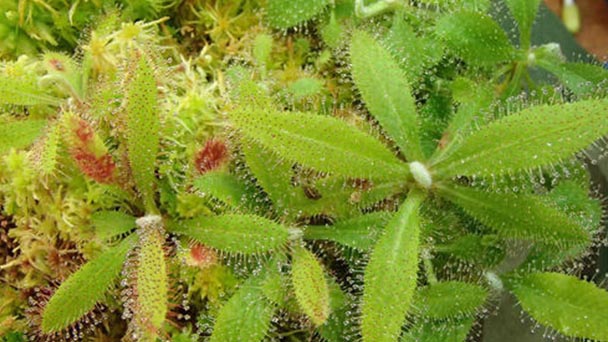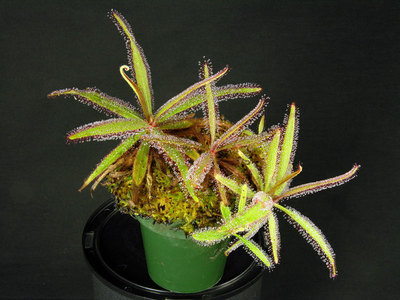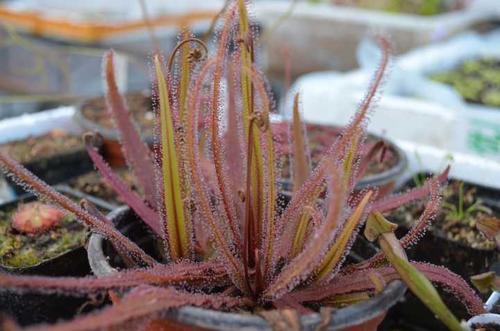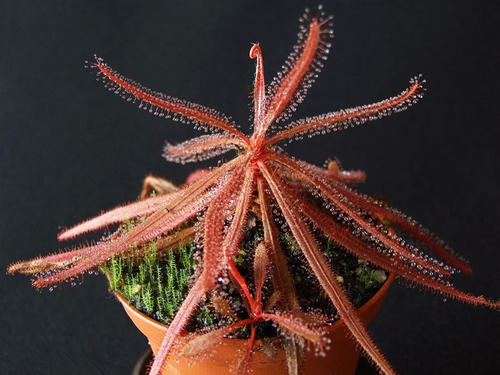Drosera Adelae (Lance-Leaf Sundew) Profile
Written by Maggie
Nov 01 2021

Drosera Adelae, also called Lance-Leaf Sundew, is a very delicate and charming large sundew. It is a tropical rainforest plant. Drosera Adelae likes a cool and humid environment. It can grow up to 25 cm in diameter.
Drosera Adelae Picture

Characteristics of Drosera Adelae
Drosera Adelae is a herb, usually perennial, 2-20 cm in diameter. Rhizome is short, with adventitious roots, often regressed leaves with root function, terminal with or without a bulbous corm. Leaves are alternate or basal and roseletate dense, headlike sticky glandular hairs, young leaves often fist roll; Stipules are membranous, often lobed. Cymes are terminal or axillary, curved when young; Calyx is 5-lobed, sparse 4-8-lobed, base more or less connate, persistent; drosera adelae has 5 petals, detached, spreading when anthesis, aggregated after anthesis, persistent apically; Stamens and petals are of the same number, alternate; Ovary is superior, 1-locule, lateral membrane placenta 2-5, ovules numerous, few; Drosera Adelae has 3-5 styles, sparse 2-6, variously divided or undivided, persistent. Capsule is loculicidal dehiscence; Seeds are small, many, exosperm with reticulate veins.
Ecological habits of Drosera Adelae
The survival temperature of Drosera Adelae is 5-37℃, and the optimum temperature is 15-30℃. Ambient humidity > 60%. The leaves of Drosera Adelae are some of the longest in the sundew world, but unlike other sundew plants, Drosera Adelae does not curl when it feeds on insects, only the glandular hairs on the sides close to the prey. Drosera Adelae is a rainforest plant that likes shade and high humidity. It grows to a maximum of 25 cm in diameter, but has smaller, reddish leaves if exposed to bright light.Its ability to reproduce is amazing.
Distribution of Drosera Adelae
Drosera Adelae originates in the mountains of Queensland, Australia. About 100 species of sundew are found in tropical and temperate regions, especially Australia and New Zealand. China has 6 kinds, 1 kind produces northeast, the rest produces each province area south of the Yangtze River and Taiwan province and other coastal islands. There is 1 species in Hengduan Mountain area.

How to Care for Drosera Adelae
Water needs to use low mineral content of water (such as rain water, pure water, etc.), suitable for the use of basin immersion method of planting, basin bottom water supply; Avoid spraying the plant with water frequently to avoid washing away mucus on the glandular hairs. Drosera Adelae is suitable for planting in the bright without strong light and high humidity of the place (indoor glass tank artificial light source is best); If fertilizer is needed, spray more than 1/5 of the indicated concentration.
Drosera Adelae Soil Care
One hundred percent Long-Fibered Sphagnum (LFS), dwelling sphagnum, a peat: sand combination (perlite also works properly for a number of growers), or a combination of LFS with some sand. Drosera Adelae is usually no longer choosy if all the different elements are accounted for (such as temperature and humidity). However, others have pronounced that they can solely get this species to develop in useless or dwelling long-fibered sphagnum. The plant pictured at pinnacle left is developing in a hundred percent LFS.
Drosera Adelae Watering
Very moist to barely moist. Usually very adaptable if all different prerequisites are favorable. In decreasing mild levels, or if unhealthy, Drosera Adelae may additionally have an extra of a tendency to rot if the water stage is stored higher.
Drosera Adelae Humidity
Much much less humidity (<25%) is wanted in cooler stipulations (i.e. under 70 F). I mainly advocate higher humidity degrees if you have currently transplanted your Drosera Adelae, for the reason that this plant (and even D. capensis) can be touchy to warmth and low humidity for a positive period, specially if the roots have been disturbed or damaged in the process. While growers have a tendency to have very differing opinions about humidity, it broadly speaking relies upon the the prerequisites that the plant life are developing in (ie lighting, temperature, etc), which can range considerably. I usually endorse experimenting till you discover what works nice in your conditions.
Drosera Adelae Fertilizer
Drosera Adelae grows nice (and largest) when fed at least as soon as a month or greater frequently. If developing in an excessive humidity environment (i.e. in a terrarium or sealed container), attempting no longer to overfeed the leaves or mould may also develop. A "paste" of freeze-dried bloodworms (mixed with some water) has been pronounced to no longer produce mildew growth, even in excessive humidity environments. Visit the feeding web page for extra info.
Drosera Adelae Pot Height
The taller the pot, the better, when it comes to developing the greatest Drosera Adelae. Larger than four or 5 inches tall would be a true start... Check out this image of the root gadget of a small plant of Drosera Adelae I unpotted (roots round 10-inches long. If you do not care about the measurement of your plant, then any pot dimension two inches or larger will be adequate, supplied and a splendid water degree is maintained. Avoid the usage of clear pots, given that the roots often increase new plantlets each time they are uncovered to light--- this wastes a lot of power from the mom plant, and will therefore minimize its viable size. Also be aware that Drosera Adelae tends to ship out greater horizontal roots if it is grown in a shallower pot. In this case, it can also commit greater strength toward propagating itself than to growing the measurement of its leaves. Choose a pot that first-class fits your preferences.
Drosera Adelae Dormancy Requirements
Drosera Adelae does no longer want dormancy if given tropical or subtropical stipulations year-round, however grows as a perennial in nature if the temperatures drop beneath freezing for a given time (Lowrie 132).
Drosera Adelae Lighting
Drosera Adelae does pretty nicely in better lighting. It will flip vivid crimson in vibrant conditions. If you favor developing Drosera Adelae safely outdoors, I'd suggest partial shade. The photoperiod no longer appears to impact dormancy. Lower mild depth tends to inspire accelerated leaf elongation, however be positive that the tentacles nonetheless preserve a purple or purple coloration, or this is a signal your plant wishes greater light. The image beneath to the left affords an instance of a wholesome plant grown in decreasing mild intensity. Also notice the expanded stem elongation on this plant as well.

Latest Updated
- Benefits of Bugleweed - 7 Science-backed Health Benefits
- Bugleweed Dangers & Side Effects - Is It Poisonous?
- How to Plant Evergreen Trees - What You Should Know
- When to Plant Evergreens - Grow Guide for Evergreen Trees
- 12 Wonderful Evergreen Shrubs for Your Garden
- 12 Popular Evergreen Plants with Pictures for Beginners
- When And How To Prune A Lilac Bush Like a Pro
- How to Grow & Care for Lilac Vine (Hardenbergia Violacea)
- Japanese Lilac Tree (Syringa Reticulata) Care & Propagation Guide
- Shumard Oak Pros and Cons - What to Know
Popular Articles
- Winter maintenance of Antirrhinum Majus
- How to Grow Terminalia Mantaly Tree
- How to Grow and Care for Crossostephium Chinense
- How to grow Antirrhinum Majus in spring
- Peristeria Elata (Dove Orchid) Profile: Info & Care Guide
- Underwatered Snake Plant (Sansevieria Trifasciata) - Signs And How To Fix
- How to Care for Brazilian Jasmine Plant (Mandevilla Sanderi)
- How to Grow & Care for Graptopetalum Purple Delight in Summer
- Rosa Chinensis (China Rose): Plant Growing & Care Tips
- How to Care for Baby Sun Rose (Aptenia Cordifolia)